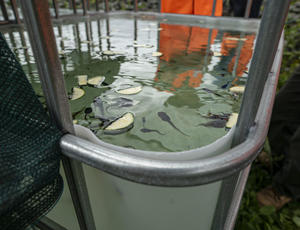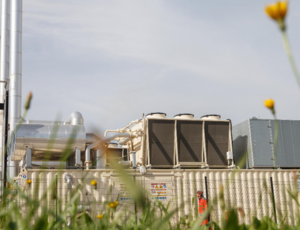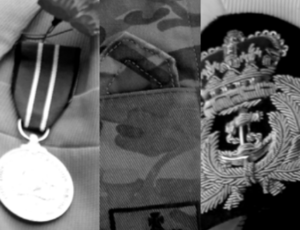As peak turtle rescue season approaches and injured turtles wash up on our shores in greater numbers, Veolia funded research by the Taronga Wildlife Hospital has revealed endangered turtle species living right beside us in our busiest harbours and waterways.
The Taronga Wildlife Hospital recently released three endangered green turtles ― Five Hook, Seven Hook, and Anna ― back into the wild after they recovered from serious injuries. That event could be seen as a happy ending, but it was actually the beginning of something intriguing.
Since their release all three have been tracked by satellites along the NSW coast thanks to a turtle research program sponsored by Veolia as part of our broader mission of ecological transformation. What that tracking has revealed about these three turtles and many others over the years is that they don’t stray far from us at all (see maps here for the journeys of Seven Hook, Five Hook and Anna).
Rather than head off into the deep blue ocean, the three turtles like many of their kind moved through and continue to live in some of our busiest harbours and coastal holiday destinations. It’s there that they can be struck by marine vehicles or encounter marine litter and fishing equipment that can kill or injure them.
“The fact that endangered turtle species live almost unseen in the waters beside our cities and urban areas is extraordinary but with that natural good fortune comes a responsibility to protect these creatures ― and we can all play a meaningful role in their preservation,” said Veolia ANZ CEO Richard Kirkman.
“We know the most common debris that causes turtles harm are plastic bags, fishing lines, hooks, small and large hard pieces of plastic, bottle tops, small fish-shaped soy sauce containers, lids, soft plastic bags and balloons.
“Consequently, one of the simplest ways to reduce the death and hospitalisation of endangered turtles this summer is to avoid buying items that can cause them harm in the first place, like plastic bottles, food wrapped in plastic, and even biodegradable bags, which may break down eventually in soil but not in the ocean. And of course we should all dispose of fish hooks, fishing line, and any other rubbish responsibly no matter where we are because even rubbish tossed aside far inland can eventually make its way to our oceans.”
Summer is the most crucial time of the year to protect our turtles according to Taronga Wildlife Hospital’s Rescue and Rehabilitation Coordinator, Libby Hall, because it is not just beach weather, it’s also peak turtle rescue season as more turtles migrate south with warm currents at exactly the same time as our waterways are busiest.
Sadly, that leads to around 40 turtles a year being taken to the hospital, with the majority of injuries caused by consuming marine debris, fish hooks and lines, or being struck by boats and jet skis. While the team works hard to save these animals the reality is that not all will make it.
Currently there are three turtles being rehabilitated in the hospital, two hawksbill turtles that arrived over the past few weeks, and a green turtle, affectionately known as Tama ― after Tamarama the beach where she was found. Tama is well on the road to recovery and likely to be released soon with another Veolia sponsored satellite tracker on her shell.
“There’s no better feeling than releasing an animal back into the wild. Being able to satellite track these endangered animals is important because it provides us with valuable information about marine ecosystems and the habitat needed by marine turtles,” said Ms Hall
“Marine debris including plastic pollution is one of the significant threats to marine turtles so it is important that everyone considers their impact on our environment and disposes of rubbish responsibly.”
Australians are extraordinarily fortunate to be able to see marine turtles in the wild, it’s an opportunity few other countries have. There are only seven species of ocean-going turtles in the world. Six of these live in Australian waters and, as we now know, often very close to where we live.
You might even be lucky enough to see one the three turtles released earlier this year. Seven Hook went all the way to the shores of Longueville in upper Sydney Harbour before returning back through the Heads to join Anna who settled in for winter at Lake Macquarie. Five Hook, meanwhile, hugged the coastline on its journey back home to near where it was found around Port Stephens, a busy tourist destination.
“For Veolia, a company that is deeply involved in the waste, energy and water sectors, and which aims to be at the forefront of creating a circular economy and work with nature, the work of the Taronga Turtle Tracking program is close to our heart,” said Mr Kirkman.
“It exemplifies our commitment to finding ways for the natural world and human activities to exist side by side. It also shows that when we come together and take responsibility for the simple things in our lives, like disposing of litter properly, we can all contribute directly to making the world a safer place for our endangered wildlife.”
If you should find an injured marine turtle on the shoreline, please contact your local vet or Taronga Wildlife Hospital on (02) 9969 2777. Taronga Wildlife Hospital is open 7 days a week 8 am to 3.30 pm for rescued marine turtles and any other species of native wildlife needing care. (See what to do if you find an endangered turtle below).
What to do if you discover an injured turtle:
Info from Marine Turtle Husbandry and Satellite Tracking paper by Taronga Zoo.
If you accidentally hook a turtle:
- Do not cut the line and let it go, as fishing line attached to hooks does more damage than the hooks themselves and will cause the animal to die a slow and painful death.
- Keep the turtle and call for professional assistance. When you do cut the line make sure a long length extends from the mouth. This will make it easier to remove the hook.
- To stop the animal from swallowing the hook further, gently tape the line to the turtle’s shell.
- Contact Taronga Zoo or your local vet for assistance
Guidelines when rescuing a turtle that needs to be transported to a hospital or vet clinic:
- When found, and when transporting a turtle, keep noise to a minimum and don’t let anyone touch the turtle unnecessarily.
- Make sure there are enough people to lift a turtle onto a blanket or turtle mat for transport. A plastic tub is another option for transporting turtles.
- Cover any injuries with a clean material so towels or straps used to cover the turtle do not make the injuries worse.
- Cover the head with a small towel but ensure the nostrils are not obstructed
- Do not remove barnacles as this causes the turtles pain and can lead to later infection.
- Cover the transport box with a towel.
- Do not use wet towels unless it is a particularly hot day as this can cause temperature shock, particularly in an air conditioned car.
- Transport turtles inside the cabin of a vehicle, not outside in trays where it can be exposed to noise, temperature changes and wind.
- Wear gloves, protective clothing, wash exposed skin after handling, and seek medical attention for any injuries you may incur during the rescue.
About Veolia ANZ
Veolia Group aims to become the benchmark company for ecological transformation. Present on five continents with nearly 220,000 employees, the Group designs and deploys useful, practical solutions for the management of water, waste and energy that are contributing to a radical turnaround of the current situation. Through its three complementary activities, Veolia helps to develop access to resources, to preserve available resources and to renew them. In 2022, the Veolia group provided 111 million inhabitants with drinking water and 97 million with sanitation, produced nearly 44 million megawatt hours and recovered 61 million tonnes of waste. Veolia Environnement (Paris Euronext: VIE) achieved consolidated revenue of 42.885 billion euros in 2022.
MEDIA CONTACT
Valeria Cheglov, Head of Communications and Public Policy | +61 0438 494 351| [email protected]





